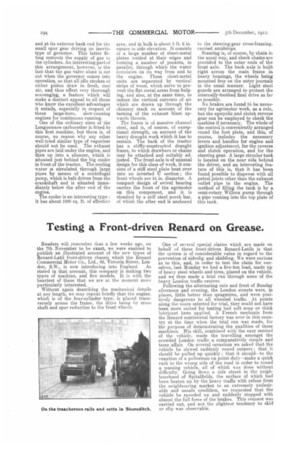Testing a Front-driven Renard on Grease.
Page 6

If you've noticed an error in this article please click here to report it so we can fix it.
Readers will remember that a few weeks ago, on the 7th November to be exact, we were enabled to publish an illustrated account of the new types of lli,enard-Latil front-driven chassis which the Renard Commercial Motor Co., Lid., 92, Victoria Street, London, S.W., is now introducing into England. As stated in that account, this company is making two types of machine, and five models. It is with the heaviest of these that. we are at the moment more particularly interested. Without again describing the mechanical details at any length, we may repeat briefly that the engine. which is of the four-cylinder type, is placed transversely across the frame, the drive being by cross shaft and spur reduction to the front wheels. One of several special claims which are made on behalf of these front-driven Renard-Latils is that the system is of considerable value in regard to the prevention of sideslip and skidding. We were curious as to this, and, in order to test the claim for ourselves, last Monday we had a five-ton load, made up of heavy steel wheels and tires, placed on the vehicle, and we then made a trial run through some of the heavy London traffic centres. Following the alternating rain and frost of Sunday afternoon and evening, the London streets were, in places, little better than quagmires, and were positively dangerous to all wheeled traffic. At points along the route selected for trial, they could not have been more suited for testing had soft soap or thick lubricant been applied. A French mechanic from the Renard continental factory was over in this country at the time when the trial run was made, for the purpose of demonstrating the qualities of these machines. His skill, combined with the easy control of the vehicle, made the travelling amongst the crowded London traffic a comparatively simple and tame affair. On several occasions we asked that the vehicle be sle wed suddenly round corners ; that it should he pulled up quickly ; that it should—to the vexation of a policeman on point duty—make a quick rush to the wrong side of the road in order to round a passing vehicle, all of which was done without difficulty. Going down a side street in the neighbourhood of Spitalfields, the surface of which had been beaten up by the heavy traffic with refuse from the neighbouring market to an extremely undesirable and unsafe condition, we requested that the vehicle be speeded up and suddenly stopped with almost the full force of the brakes. This request was carried out, and not the slightest tendency to skid or slip was observable.


























